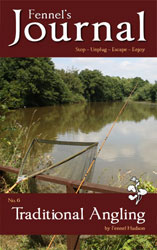What is Traditional Angling? A Traditional Angler's View
In the video above, Fennel shares his view on what it means to be a traditional angler. It includes footage of his BBC showreel preparation from 2013 and is updated with his present-day view.
Fennel's Introduction, 16 June 2017
Today marks the start of the traditional coarse fishing season in the UK. So I’ve decided to share a little fishing-related video with you. Some of it was recorded in 2013 as part of an interview I did with the BBC to help them shape a TV series that eventually became The Big Fish.
The Beeb asked me to articulate what ‘traditional angling’ means to me and how it compares to the modern angling scene. I gave my view of how the modern sport evolved since the late 1940s, highlighting the differences between the doctrines of Bernard Venables and Richard Walker, i.e. seeing angling through an artist’s or an engineer’s eyes and the associated tackle and tactics their legacies encouraged.
The film provides a nice introduction to my book Traditional Angling, Fennel's Journal No. 6, the extended edition of which will be published at the end of this month.
There's continuity in this video with a blog I wrote on the subject in 2013. I've included it here for you. As I read it now, as as I watch the video, I'm convinced that Traditional Angling is a mindset rather than something defined by the tackle used.
What is Traditional Angling (blog from 2013)
Traditional Angling takes many guises. At the Priory it's about fishing in an uncompetitive and ethical way, where catching fish is secondary to the experiences and beauty of a day spent in the countryside. Put simply, traditional angling is about getting closer to Nature in a watery environment.
Fishing in this manner enables the traditional angler to feel more connected his or her environment. The aesthetics and approach feel right. The angler is ‘compleat’. He or she has taken courage in their sense of individuality and bucked the trend, doing things differently to the crowd and enjoying a sense of freedom that allows them to savour their sport even more. They are in, and of, the Quiet Fields.
A swishing of bamboo rods
The traditional angling movement gathered speed in the 1980s, reacting to the growing seriousness and competitiveness of modern ‘specimen hunting' in angling. Here, tackle and tactics can have almost military lethality, with ‘rigs’ that can hook the fish on behalf of the angler. Traditional anglers stepped forward to balance things, adopting a more leisurely approach to their sport.
Today, the stereotypical traditional angler can be found using a 'split cane' bamboo rod and centrepin reel, carrying a wicker creel and dressed in traditional country tweeds. There are different degrees of purism. Extreme traditionalists take things to the extreme: their pursuit of ‘perfection’ becomes more serious than the modern movement they are reacting to, whilst others are content to blend old with new. Either way, they have noticed something in modern fishing that doesn't sit comfortably with their set of values.
Traditional fishing tackle enables the traditionalist to get closer to Nature. Those fishing items of either vintage provenance or traditional styling have the aesthetic and hand-crafted attributes that make them sit so nicely in a natural environment. Bamboo rods, willow creels, swan quill floats and hand-made reels demonstrate the passion and skill of the craftsman who made them.
The use of natural materials in the construction of traditional fishing tackle makes for an organic angling experience that is more in tune with the angling of our forefathers. It allows us to escape the urgency of the modern world and connect more completely with the slow-moving world of water. Traditional angling is not a re-enactment, it's a very real demonstration of personal taste.
Anglers use traditional fishing tackle for many reasons – some may have always used it, or they may have been drawn to its appeal after seeing so much soulless modern tackle on display in tackle shops. They may have been inspired to use vintage tackle by reading books by authors such as Chris Yates, or, like me, they may associate with the items and customs of a past age, adopting them to live a more sensitive and leisurely existence.
Your own take
Traditional angling is founded upon a desire to buck the trend, to be individual and to be free from the pressures of modern society. It's crucially important that you remain true to yourself. Use the tackle and tactics that feel right to you; wear clothing that makes you feel comfortable and good about yourself. Traditional angling is not an act – it's a statement that says we are different, that we are seeking a quieter existence. With our days so filled with poetic beauty, we know and can shout aloud that traditional angling is an art. Science and technology have no place here. We are free of them.
I hope that this guide will help to clarify your understanding of traditional angling and explain why I use the tackle that I do. Traditional angling is a deeply personal thing. It’s more than an activity or a sport; it’s a philosophy, a way of life. You should make of it what you want, make the tackle choices and apply however much detail as you need to ensure your traditional angling makes you happy; happy enough for you to grow into this new sense of being, to celebrate and cherish the natural world.
 If you like this blog, you'll like Fennel's book Traditional Angling.
If you like this blog, you'll like Fennel's book Traditional Angling.
Please also subscribe to the Fennel on Friday weekly email. You'll receive either a blog, video or podcast sent to you in time for the weekend.



